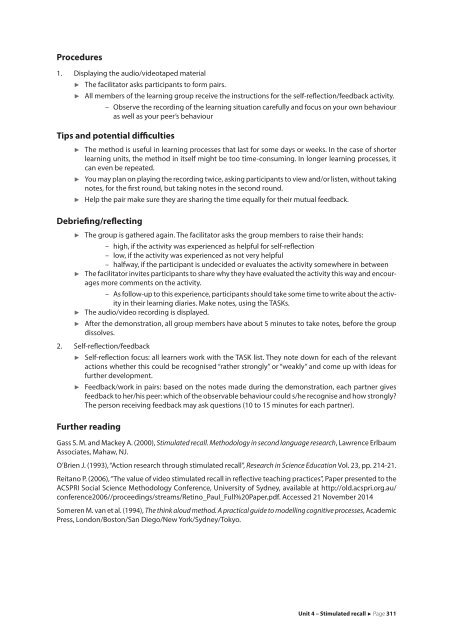TASKs for democracy
4NYw4W
4NYw4W
Create successful ePaper yourself
Turn your PDF publications into a flip-book with our unique Google optimized e-Paper software.
Procedures<br />
1. Displaying the audio/videotaped material<br />
<br />
<br />
The facilitator asks participants to <strong>for</strong>m pairs.<br />
All members of the learning group receive the instructions <strong>for</strong> the self-reflection/feedback activity.<br />
– Observe the recording of the learning situation carefully and focus on your own behaviour<br />
as well as your peer’s behaviour<br />
Tips and potential difficulties<br />
<br />
<br />
<br />
The method is useful in learning processes that last <strong>for</strong> some days or weeks. In the case of shorter<br />
learning units, the method in itself might be too time-consuming. In longer learning processes, it<br />
can even be repeated.<br />
You may plan on playing the recording twice, asking participants to view and/or listen, without taking<br />
notes, <strong>for</strong> the first round, but taking notes in the second round.<br />
Help the pair make sure they are sharing the time equally <strong>for</strong> their mutual feedback.<br />
Debriefing/reflecting<br />
<br />
<br />
The group is gathered again. The facilitator asks the group members to raise their hands:<br />
– high, if the activity was experienced as helpful <strong>for</strong> self-reflection<br />
– low, if the activity was experienced as not very helpful<br />
– halfway, if the participant is undecided or evaluates the activity somewhere in between<br />
The facilitator invites participants to share why they have evaluated the activity this way and encourages<br />
more comments on the activity.<br />
– As follow-up to this experience, participants should take some time to write about the activity<br />
in their learning diaries. Make notes, using the <strong>TASKs</strong>.<br />
The audio/video recording is displayed.<br />
After the demonstration, all group members have about 5 minutes to take notes, be<strong>for</strong>e the group<br />
dissolves.<br />
2. Self-reflection/feedback<br />
<br />
<br />
Self-reflection focus: all learners work with the TASK list. They note down <strong>for</strong> each of the relevant<br />
actions whether this could be recognised “rather strongly” or “weakly” and come up with ideas <strong>for</strong><br />
further development.<br />
Feedback/work in pairs: based on the notes made during the demonstration, each partner gives<br />
feedback to her/his peer: which of the observable behaviour could s/he recognise and how strongly?<br />
The person receiving feedback may ask questions (10 to 15 minutes <strong>for</strong> each partner).<br />
Further reading<br />
Gass S. M. and Mackey A. (2000), Stimulated recall. Methodology in second language research, Lawrence Erlbaum<br />
Associates, Mahaw, NJ.<br />
O’Brien J. (1993),“Action research through stimulated recall”, Research in Science Education Vol. 23, pp. 214-21.<br />
Reitano P. (2006),“The value of video stimulated recall in reflective teaching practices”, Paper presented to the<br />
ACSPRI Social Science Methodology Conference, University of Sydney, available at http://old.acspri.org.au/<br />
conference2006//proceedings/streams/Retino_Paul_Full%20Paper.pdf. Accessed 21 November 2014<br />
Someren M. van et al. (1994), The think aloud method. A practical guide to modelling cognitive processes, Academic<br />
Press, London/Boston/San Diego/New York/Sydney/Tokyo.<br />
Unit 4 – Stimulated recall Page 311


